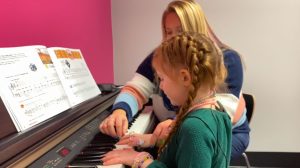CINCINNATI — A new drug treatment clinic opening in southwest Ohio hopes to flatten the curve on a rapidly rising trend of overdose deaths among young people.
What You Need To Know
- Cincinnati Children’s Hospital Medical Center’s new Opioid Use Treatment Clinic treat patients between the ages of 16 to 21
- The clinic aims to provide age-specific care to patients addicted to drugs like heroin, Percocet, oxycontin, fentanyl, oxycodone, hydromorphone and Vicodin
- Overdose deaths among teens have tripled in the last two years, CDC data shows
- Plans call for program expansion in the future to address other substance use disorders
Cincinnati Children’s Hospital Medical Center created the Opioid Use Treatment Clinic for those between the ages of 16 to 21.
The clinic provides tailored, age-specific care to patients struggling with addiction to drugs like heroin, Percocet, oxycontin, fentanyl, oxycodone, hydromorphone and Vicodin.
It’s one of the few outpatient clinics offering medication treatment to people under 18 years old in the region.
“Opioid addiction is still a growing problem in adolescents and young adults,” said Daniel Cohen, a nurse practitioner in the hospital’s division of Adolescent and Transition Medicine. “We are looking forward to helping make a difference in the lives of young people who want help.”
Drug overdoses are the largest injury-related cause of death in the United States, according to the Centers for Disease Control and Prevention (CDC). And those numbers keep rising.
Overdose deaths among teens have tripled in the last two years, CDC data shows.
The CDC noted that the drastic rise in overdose deaths in teens directly results from fentanyl. Counterfeit medications and street drugs may include fentanyl, which puts youth at greatest risk of overdose and death, said Tom Synan, police chief for the Village of Newtown, Ohio.
The organization PreventionFiIRST! surveyed more than 26,260 students in Southwest Ohio between September 2021 and December 2021. Of those students, 2.0% of seventh through 12th-graders reported using prescription drugs not prescribed to them in the past 30 days. About 0.6% of students reported using other illicit drugs during that period.
“You’re talking about high school students, college students who may use some type of pill that they got from the internet or social media or they may get addicted to some kind of medication, like an opioid from some kind of medical procedure,” Synan said.
“To have the medical community spearhead this is big because it helps divert people out of the criminal justice system and treats addiction as it should be treated: as a mental medical health condition,” he added.
The clinic came about as the result of a “need in the community for adolescent and young adult opioid use disorder treatment using medication assisted treatment,” Cohen said.
Opioid use disorder occurs when opioid use causes significant impairment and distress. Typically, those with OUD struggle with their ability to cut down or control their use of an opioid they’re using, resulting in struggles at work, school, or home.
Roughly 2.7 million people in the U.S. report suffering from OUD, per the CDC.
The clinic provides office-based outpatient services. It’s housed in the Teen Health Center at Cincinnati Children’s Burnet Campus at 3401 Burnet Ave. It’s a little over a mile from the University of Cincinnati.
Synan, who serves as co-chair of interdiction for the Hamilton County Addiction Response Coalition, called Cincinnati Children’s involvement in the fight against substance abuse “a major win for the region.”
“It’s pretty significant to have a medical facility spearheading this and getting to young people and trying to intervene with scientific, evidence-based treatments,” he added. “Getting in early and helping young people to get off drugs and then hopefully prevent them from using later on in life.”
To create the clinic, a multidisciplinary team of medical professional and subject experts assembled needed the infrastructure, processes and procedures.
Cincinnati Children’s based the clinic on a national model known as Office Based Opioid Treatment, or OBOT. The model received support from several health-related organizations, including the Substance Abuse and Mental Health Services Administration and the American Academy of Pediatrics.
Providers in the Opioid Use Treatment Clinic have gone through specific training and are licensed to prescribe Suboxone as a treatment option.
Suboxone has a much lower chance of overdose compared to methadone, Cohen said. Patients who qualify will receive up to a month’s supply of medication.
“Although this treatment is safe and effective, teens with opioid addiction are much less likely to receive treatment than adults,” Cohen said.
The FDA approved the use of Suboxone for patients 16 years and older. Cohen said Cincinnati Children’s will assist patients 15 and younger with community therapy programs.
The clinic is voluntary. Patients don’t need a referral, but they can receive a referral from another provider, such as their primary care provider, Cohen. Parents can also refer to their children.
In some cases, patients can seek confidential treatment without parental consent, Cohen said.
“We want to provide young people with the best possible chance to beat addiction,” he added. “Cincinnati Children’s is a safe space for a young person battling addiction to powerful opioids.”
Beyond the medication, social workers in the clinic connect patients to community providers for therapy services. That’s an important component of treatment for patients with opioid use disorder, Cohen said. The clinic plans to offer in-house therapy options soon.
Cincinnati Children’s also has access to other related services to help with what led those young people to turn to drug use and to become addicted, Synan said.
He feels that’s vital to not only addressing the addiction but also the underlying causes that may have led someone to use drugs. That could include things like family history of drug use, early life trauma, mental health issues or other “adverse childhood experiences,” Synan added.
The medical center also is partnering with treatment programs for adults, including UC Health’s program, to assist with the transition of care for patients who age out of Cincinnati Children’s.
While currently focused on medication for opioid use disorder, but plans call for program expansion in the future to address other substance use disorders.
“One thing we know is when there’s a continuum of care model, when someone’s supportive from the beginning to the end, they have a better chance of recovering and staying in recovery,” Synan said. “Having a hospital system or a group hospital system that works together is a significant change in how we respond to addiction.”
For more information, call 513-636-4748 or visit Cincinnati Children’s Hospital Medical Center website.




